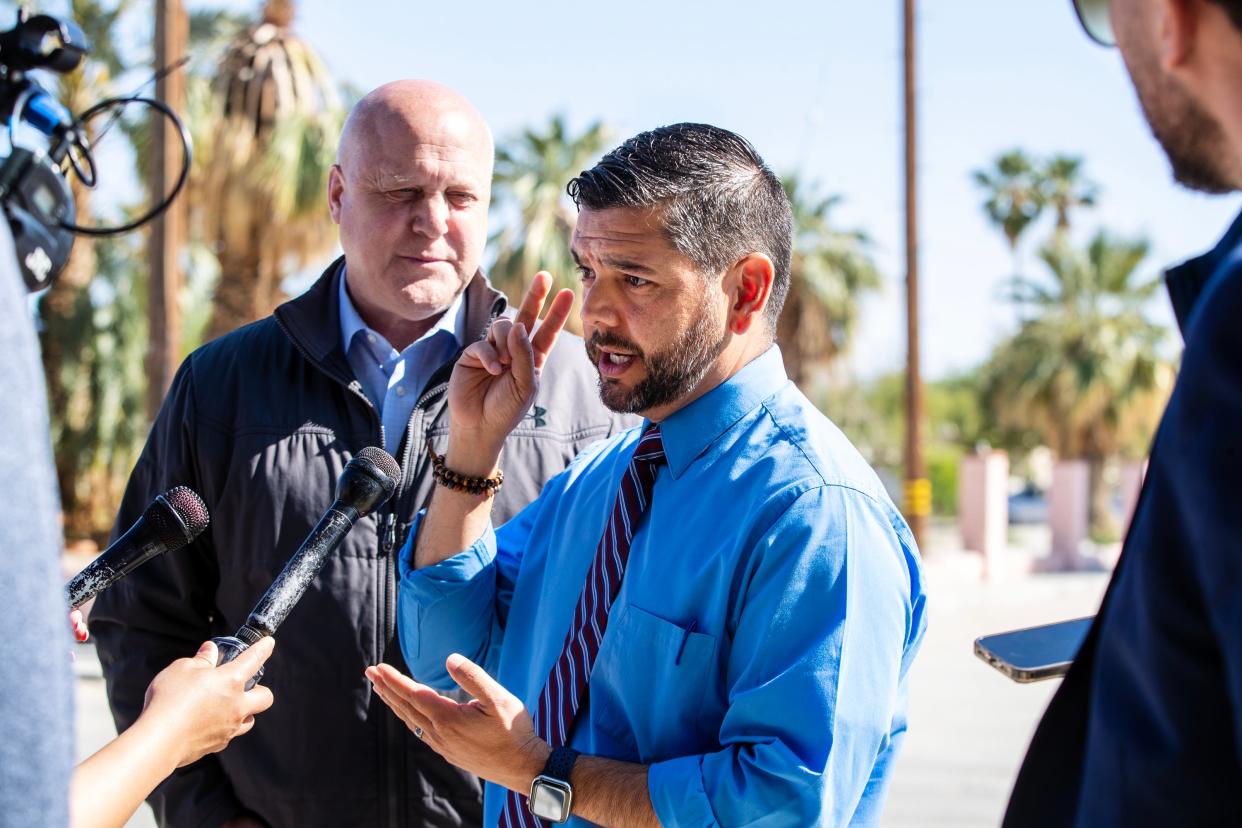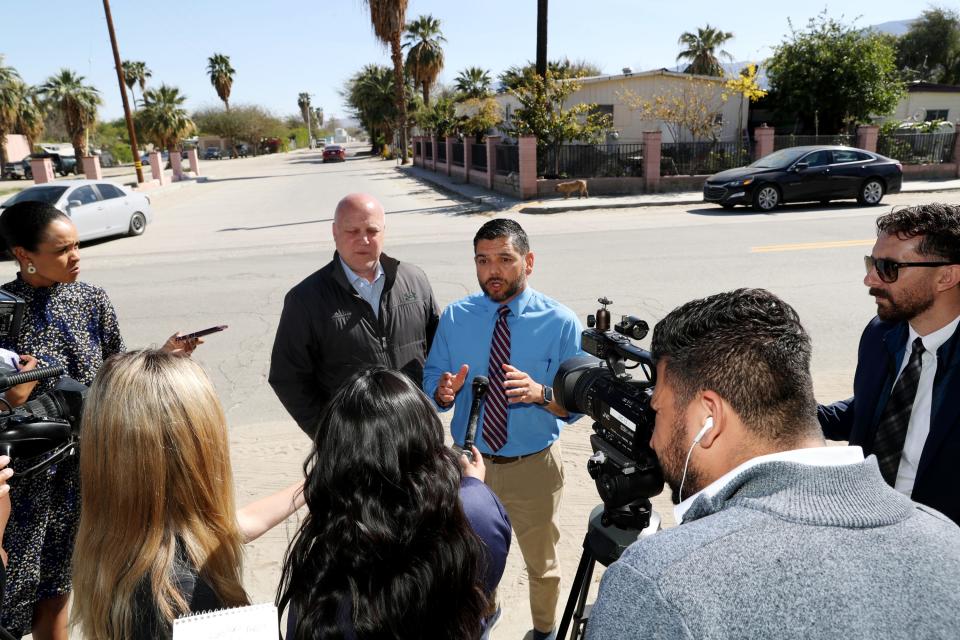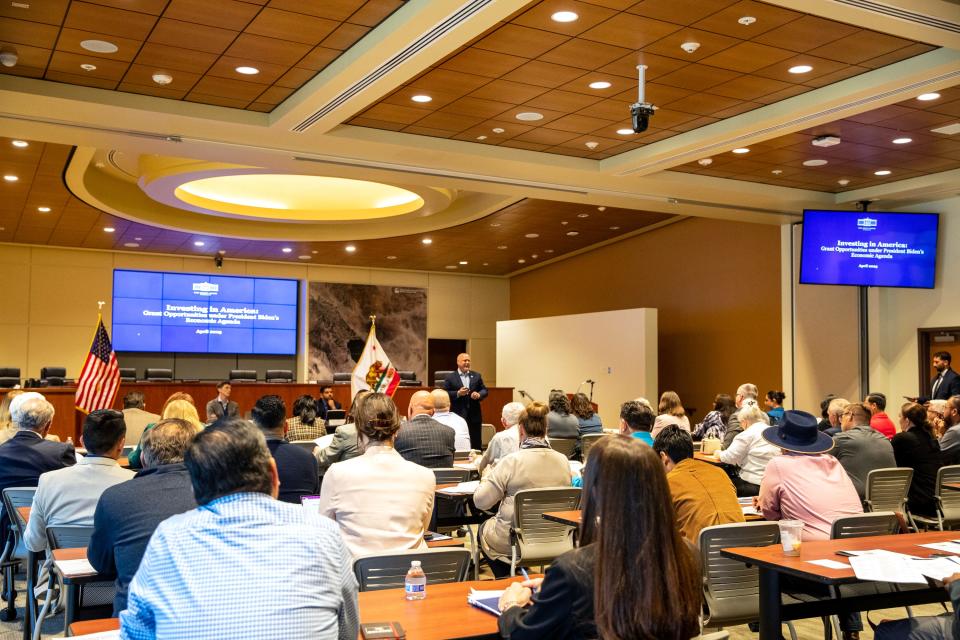Could Biden’s infrastructure law bring funding to Coachella Valley’s projects?

- Oops!Something went wrong.Please try again later.
- Oops!Something went wrong.Please try again later.
As Coachella Valley officials eye the billions on the table to address dire infrastructure needs like local mobile home parks without clean drinking water, White House senior advisor and infrastructure coordinator Mitch Landrieu visited Thermal on Tuesday to tout funding opportunities available under the Bipartisan Infrastructure Law.
Landrieu joined U.S. Rep. Raul Ruiz, a Democrat who represents the 25th Congressional District, for a tour of Oasis Mobile Home Park where the infrastructure needs are particularly dire. The mobile home park has been repeatedly cited by the U.S. Environmental Protection Agency over several years for having water that's contaminated with dangerous levels of arsenic — a known carcinogen that can cause severe health problems if consumed at high levels over a prolonged period. Residents currently rely on bottled water to drink, while officials work to both relocate Oasis residents and expand public water lines across the eastern Coachella Valley.
“It's important to bring (Landrieu), from the White House. . . to the district to get a first-hand look at the infrastructure needs that we have," Ruiz said. "And we have multiple needs throughout the district. But the Oasis Mobile Home Park really elucidates the complexity and the public health challenges that we have due to the lack of infrastructure, like arsenic in water, dilapidated roads with dust, improper sewage or trash collection in areas that pose immediate and long-term harm."
As President Biden’s senior advisor and infrastructure coordinator, Landrieu is tasked with coordinating the implementation of the $1 trillion law, which includes $550 billion in new funding. Landrieu’s visit was part of the Biden Administration’s Investing in America Tour. Following the Oasis Mobile Home Park visit, Landrieu and Ruiz hosted a roundtable presentation in Thermal to hear about the region’s infrastructure needs and discuss available grants for local projects.

“There is no better place to come to that better exemplifies the president's vision. The first part of the job is showing up and listening to people to make sure that they know that the president sees them… Whether it's roads, bridges, airports, ports, waterways, clean air, safe water, high-speed internet, a clean energy economy, this is an area of the country that has obviously tremendous challenges, but really spectacular opportunity,” Landrieu said.
The years-long crisis at Oasis Mobile Home Park and other east valley mobile home parks that largely house farmworkers has sparked visits from other state and federal officials, including the region’s Environmental Protection Agency Administrator, as well as waves of Coachella Valley Water District, county, state, and federal funding. The county is currently implementing the Oasis Housing Opportunity Program, which will draw from $30 million in state funding approved for relocation from Oasis, but the amount that individual families will get and how many families can participate is still unclear.
“I would want (officials) to give us new homes, they have helped us, but we’ve already been waiting a long time and when we go to meetings they always say the same thing, that they are going to fix the water. But we don’t know when we’ll be able to move from here to new homes,” Martina Zacarias, a farmworker and long-time resident of the mobile home park told The Desert Sun in Spanish.
Officials have said that relocation efforts have been difficult due to a lack of available affordable housing in the eastern Coachella Valley, which also has led to the county recently putting up barriers to prevent new tenants from moving in, as part of an effort to ultimately close the park.
Ruiz said during Tuesday’s roundtable that he hopes improved infrastructure in the area would in turn help spur more housing development, providing new homes that residents of Oasis and other troubled mobile home parks could move into.
“One of the big takeaways (of the relocation process) with the water district and others, is in order to build preferential housing for farmworkers, we need to lay down the pipes for the sewage, for the water, that comes first," Ruiz said. "And if you build it, they’ll come, which is why the infrastructure conversation is so important.”
What is the Bipartisan Infrastructure Law?
Biden signed the Infrastructure Law in November 2021, marking the largest investment in the country’s infrastructure in decades. The largest chunk of the $1.2 trillion pot goes toward transportation: $110 billion for roads, bridges, and other major projects, $66 billion for rail, $39 billion for public transit, $25 billion for airports, $10 billion for electric buses, and $8 billion for electric vehicles, among other transportation investments.
The second big funding category is for energy, environment, and climate projects, with $55 billion for water infrastructure, $50 billion for resilience, $21 billion for environmental remediation, and $20 million for power infrastructure. Another $65 billion is set aside for high-speed internet.
The Infrastructure Law was followed by the Inflation Reduction Act, signed by Biden in August 2022, which invests $370 billion in energy security and climate change, representing the country’s largest investment toward addressing climate change.
'An equity bullseye'
Under the White House’s Justice40 Initiative, the federal government is aiming to send 40% of investments from the Infrastructure Bill will to disadvantaged communities that are “marginalized, underserved, and overburdened by pollution,” such as Thermal and other unincorporated communities in the eastern Coachella Valley.
“The Justice40 Initiative will make sure that resources go to disadvantaged and historically underrepresented, under-resourced communities that have been left out and left without for so long, just like the ones that we have here,” said Ruiz. “In California, if you were to create an equity bullseye, the center of that target would be right here in my district. It is the most impoverished district with a lot of social inequalities and disparities.”
Rural and disadvantaged communities have often struggled to compete for big federal dollars due to a lack of staff capacity, while more affluent and bigger municipalities can afford to hire grant writers. Ruiz said the federal government is working to address this through the Justice40 Initiative and providing funding for technical assistance on grant proposals.
What projects could get funding in the valley?
In addition to eastern Coachella Valley water projects, Ruiz listed off several areas where the Coachella Valley and surrounding region could be ripe for Infrastructure Bill funding: lithium extraction near the Salton Sea, hydrogen fueling for semi-trucks and other opportunities to reduce air pollution along the I-10 corridor, renewable energy development, fixing local roads and bridges, expanding high-speed internet, and water conservation.

Over 100 people representing local governments, agencies, and organizations seeking infrastructure dollars attended the roundtable discussion. Programs highlighted at the discussion included pollution prevention grants, funding for clean school buses, electric vehicle charging infrastructure grants, and energy efficiency and HVAC replacements for public schools.
During the discussion portion of the meeting, Roxana Chavez, with Líderes Campesinas, stressed the electrical infrastructure needs in areas like Salton City, which face frequent blackouts. Coachella Councilmember Denise Delgado said the city has a lot of roads that need repairs, including street widening or bridge-building projects, and also needs to focus on reducing pedestrian fatalities.
What projects have received funding so far?
So far, California has received $18.4 billion in funding from the Infrastructure Law benefitting over 633 specific projects, more funding than any other state.
About 20 funded projects have been announced in the Coachella Valley so far. Projects awarded funding include:
$640,000 for Riverside County to develop a safe streets action plan for unincorporated communities.
$575,445 to widen and rehabilitate the Ramon Road bridge at Landau Boulevard.
$4 million to replace the Cathedral Canyon Drive low-water crossing over Whitewater River with a four-lane bridge.
$2.9 million to replace the Avenue 50 low-water crossing over the Coachella Valley Stormwater Channel with a six-land bridge.
$206,300 for the city of Desert Hot Springs to improve pedestrian signals along Palm Drive.
$5.7 million for a planned expansion and renovation of the baggage claim area at Palm Springs International Airport.
$720,000 for Palm Desert's 'Vision Zero' pedestrian safety program.
Previous reporting from Desert Sun reporter Eliana Perez was used in this story.
This article originally appeared on Palm Springs Desert Sun: Coachella Valley officials look for funding from infrastructure bill

